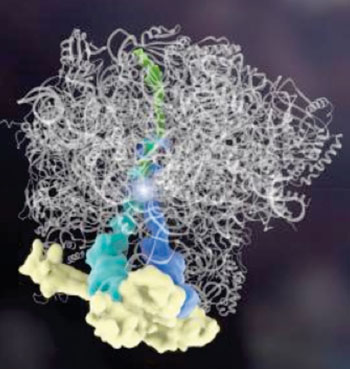Challenging Classic Science Principles, New Research Finds New Role for Proteins
By LabMedica International staff writers
Posted on 15 Jan 2015
A new study revealed for the first time that the essential components of a protein, called amino acids, can be assembled without blueprints—DNA and an intermediate template called messenger RNA (mRNA). Researchers have observed an instance in which another protein specifies which amino acids are added. Posted on 15 Jan 2015
“This surprising discovery reflects how incomplete our understanding of biology is,” stated first author Peter Shen, PhD, a postdoctoral fellow in biochemistry at the University of Utah (Salt Lake City, USA). “Nature is capable of more than we realize.”

Image: A new finding goes against dogma, showing for the first time that the building blocks of a protein, called amino acids, can be assembled by another protein, and without genetic instructions. The Rqc2 protein (yellow) binds tRNAs (dark blue, teal), which add amino acids (bright spot in middle) to a partially made protein (green). The complex binds the ribosome (white) (Photo courtesy of Janet Iwasa, PhD, University of Utah).
The findings were published January 2, 2014, in Science. To put the new finding into perspective, the process is similar to a well-run factory. Ribosomes are apparatuses on a protein assembly line, linking together amino acids in an order specified by the genetic code. When something goes awry, the ribosome can shop, and a quality control crew is summoned to the site. To clean up the mess, the ribosome is disassembled, the blueprint is thrown out, and the partly constructed protein is recycled.
However, these new findings suggest a remarkable role a member of the quality control group, a protein conserved from yeast to man named Rqc2. Before the incomplete protein is recycled, Rqc2 prompts the ribosomes to add just two amino acids (of a total of 20)—alanine and threonine—over and over, and in any order. Similar to an auto assembly line that keeps going in spite of having lost its commands, it captures what it can and smacks it on. “In this case, we have a protein playing a role normally filled by mRNA,” commented Adam Frost, MD, PhD, assistant professor at University of California, San Francisco (UCSF; USA) and adjunct professor of biochemistry at the University of Utah. He shares senior authorship with Jonathan Weissman, PhD, a Howard Hughes Medical Institute investigator at UCSF, and Onn Brandman, PhD, at Stanford University (CA, USA). “I love this story because it blurs the lines of what we thought proteins could do.”
Similar to a partially constructed car with extra horns and wheels attached to one end, a condensed protein with an apparently random sequence of alanines and threonines looks strange, and probably does not work normally. But the nonsensical sequence likely serves specific purposes. The code could signal that the partial protein must be destroyed, or it could be part of a test to see whether the ribosome is working correctly. Evidence suggests that either or both of these processes could be faulty in neurodegenerative diseases such as amyotrophic lateral sclerosis (ALS), Alzheimer’s, or Huntington’s.
“There are many interesting implications of this work and none of them would have been possible if we didn’t follow our curiosity,” said Dr. Brandman. “The primary driver of discovery has been exploring what you see, and that’s what we did. There will never be a substitute for that.”
The scientists first considered the unusual phenomenon when they saw evidence of it with their own eyes. They modified a technique called cryo-electron microscopy to flash freeze, and then visualize, the quality control machinery in action. “We caught Rqc2 in the act,” said Dr. Frost. “But the idea was so far-fetched. The onus was on us to prove it.”
Extensive biochemical analysis was needed to validate the scientist theory. New RNA sequencing techniques showed that the Rqc2/ribosome complex had the potential to add amino acids to stalled proteins because it also bound tRNAs, structures that bring amino acids to the protein assembly line. The specific tRNAs they saw only carry the amino acids alanine and threonine. The defining moment came when they determined that the stalled proteins had extensive chains of alanines and threonines added to them. “Our job now is to determine when and where this process happens, and what happens when it fails,” concluded Dr. Frost.
Related Links:
University of Utah













